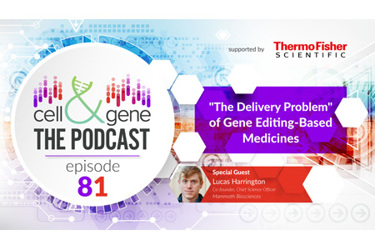Mammoth Biosciences On Epigenetic Editing

By Erin Harris, Editor-In-Chief, Cell & Gene
Follow Me On Twitter @ErinHarris_1

Cell & Gene: The Podcast features some of the CGT sector’s brightest leaders who share their expertise on the timeliest topics and trends. If you can’t tune in to every episode, I’ve got you covered. Here are highlights, quotes, and more from a recently aired episode.
The Episode:
Guest At-A-Glance
Lucas Harrington is the co-founder and CSO of Mammoth Biosciences.
Organization At-A-Glance
Headquartered in Brisbane, CA, Mammoth Biosciences is a biotechnology company focused on leveraging its proprietary ultracompact CRISPR systems to develop potential long-term curative therapies for patients with life-threatening and debilitating diseases. Harrington co-founded Mammoth Biosciences with CRISPR pioneer and Nobel laureate Jennifer Doudna as well as Trevor Martin and Janice Chen.
Episode Highlights
Delivery is THE Biggest Challenge in Gene Therapy
Harrington shares that he feels that ten out of ten professionals in the CRISPR field will state delivery as the biggest challenge in gene therapy. And that the standard delivery technologies available not only for CRISPR but also for cell gene therapy more broadly are LNP and AAV, and that AAV, especially, is imperfect. And so, one of Mammoth’s goals is to examine the diversity of CRISPR and optimize it to achieve smaller CRISPR systems that work very robustly – as robustly as the much larger CRISPR systems. As such, Mammoth works with different platforms that are approximately one-third to half the size of traditional Cas9 systems, making it practical to deliver not just the CRISPR system with an AAV, but also all the other elements that are required to deliver a gene editing therapy.
The Excitement Around Epigenetic Editing
Epigenetic editing is one of the novel editing modalities that Mammoth is exploring as part of its gene editing platform. The technology allows for the modification of gene expression without altering the underlying DNA sequence. Harrington explains that by incorporating epigenetic editing into its platform, Mammoth may be able to expand the possibilities for precise gene regulation and potentially address a wider range of genetic disorders with improved safety profiles and therapeutic outcomes.
Top Quotes
2:39: “There are actually hundreds of thousands of different flavors of CRISPR.”
5:41: “[Ex vivo delivery] is pretty straight forward. There is no real delivery problem. You can very directly insert the material into the cells in vivo. There has been a lot less actual advancement by the existing CRISPR technology. A few select examples, in particular targeting the liver, right where we have non-viral delivery LNP similar to what you might use for vaccines, and where you're actually going and changing the hepatocytes in the liver to make those genetic changes. So that seems to work fairly well. But obviously the vast majority of diseases are not caused by mutations in liver cells, and so it really has been a longstanding challenge in the field.”
12:06: “… being able to target tissues outside of the liver. And the muscle and brain are really the focus, currently. I think I think it has also been important for us to be able to focus on just one of the editing strategies.”
There’s More Where That Came From
Tune into the full-length episode to hear Harrington explain Mammoth’s origin story that involves Co-Founder CRISPR pioneer and Nobel laureate Jennifer Doudna. And he takes a deep dive into new editing modalities beyond double stranded breaks, including base editing, and epigenetic editing.
